This article was co-authored by Payam Daneshrad, MD. Dr. Payam Daneshrad is a board certified Otolaryngologist, a board eligible Facial Plastic Surgeon, and the Owner and Director of Daneshrad Clinic in Los Angeles, California. With over 19 years of experience, Dr. Daneshrad specializes in adult and pediatric Otolaryngology-head and neck surgery, packing-less nasal surgery, minimally invasive sinus surgery, and snoring treatment. He also uses the newest surgical ENT techniques for tonsillectomy, adenoidectomy, thyroidectomy, and parathyroidectomy. Dr. Daneshrad graduated with a BS and the highest honors from the University of California, Berkeley. He earned his Doctor of Medicine (MD) from Tulane University School of Medicine, where he was accepted into the AOA, the medical honor's society, and the Tulane University School of Public Health. Dr. Daneshrad received his medical training from the University of Southern California, where he currently serves as an Associate Clinical Professor. Dr. Daneshrad is the Otolaryngologist and Facial Plastic Surgeon for the Los Angeles Sparks and the athletic teams of Loyola Marymount University.
There are 14 references cited in this article, which can be found at the bottom of the page.
wikiHow marks an article as reader-approved once it receives enough positive feedback. This article has 31 testimonials from our readers, earning it our reader-approved status.
This article has been viewed 777,206 times.
Fungal ear infections can cause a variety of unpleasant symptoms like pain and difficulty hearing, but the good news is they’re relatively easy to treat with the help of a doctor. There are also things you can do at home to help reduce your discomfort in the meantime. This article will walk you through the best way to treat your fungal ear infection so it clears up.
Things You Should Know
- Put 2-3 drops of hydrogen peroxide in your infected ear canal. Wait 10 minutes, then tilt your head and let the fluid drain out.
- Place a warm towel over the infected ear to relieve pain and increase blood flow (which leads to faster recovery).
- For a severe infection that won't clear up on its own, visit your doctor for prescription ear drops. Follow your doctor's instructions for dosage.
Steps
Using Medications
-
1Know when to consult your doctor. When you have an ear infection, it is best to visit your doctor to get an accurate diagnosis and to find out the best course of treatment.[1] If you are experiencing intense pain, losing your hearing ability, or experiencing any other unusual symptoms, you should seek professional help.[2]
- Your doctor can clean your ear canal thoroughly with a suction device and provide medications to treat your ear infection.
- Your doctor may also recommend over-the-counter medications for pain or prescribe medication if the pain is severe.[3]
-
2Use antifungal ear drops.[4] Clotrimazole 1% solution is the most popular antifungal medicine that doctors prescribe for the treatment of fungal ear infections. It kills both Candida and Aspergillus. This drug works by inhibiting the enzyme used to convert ergosterol. Ergosterol is needed by the fungus to maintain the integrity of its membrane. With clotrimazole, the fungal growth is inhibited by depleting levels of ergosterol.[5]
- Keep clotrimazole’s side-effects in mind. These may be ear irritation, burning, or discomfort.[6] However, side effects are not as common with the topical forms of clotrimazole as with the oral form.
- To use clotrimazole, wash your hands with running water and mild soap. Clean the ear with warm water until any visible secretions are gone. Softly pat the ear dry with a clean cloth. Do not vigorously wipe the remaining liquid off. Doing so can exacerbate the condition.[7]
- Lie down or tilt your head sideways to expose the ear canal. Straighten your ear canal by pulling your earlobe downward, then backward. Apply two to three drops of clotrimazole into your ear. Keep your ear tilted for two to three minutes to allow the solution to reach the infected area. And then tip your head, pouring out the medicine into a napkin.[8]
- Replace the cap to the bottle and store the medication out of sight and reach of children. Store it in a dry and cool place. Avoid direct sunlight or heat.[9]
- If clotrimazole does not get rid of your ear infection, then your doctor may decide to try a different antifungal agent, such as miconazole.[10]
Advertisement -
3Get a prescription for fluconazole (Diflucan). If you have a more severe fungal ear infection, fluconazole may be prescribed by your doctor. It works just like clotrimazole. The most common side effects are a headache, nausea, dizziness, change in taste, loose stools, abdominal pain, skin rash, and elevation of liver enzymes.[11]
- Fluconazole is taken in tablet form. Doctors normally prescribe one dose of 200mg for one day and then 100mg daily for three to five days.[12]
-
4Avoid antibiotics. Antibiotics are only effective in the treatment of bacterial infections, so they will not combat fungal infections.
- Antibiotics can even worsen fungal infections since they can potentially kill good bacteria residing in the ear or other parts of the body — the bacteria that is fighting your fungal infection.[13]
-
5Follow up with your physician. You will need to see your physician again in a week or so to see if the treatment is working. If the treatment is not working, then your doctor may try a different option.
- Also, make sure to call your physician if your symptoms get worse or do not improve.
Using Home Remedies
-
1Use hydrogen peroxide. Add two to three drops to the infected ear with a medicine dropper. Let the drops sit in the ear canal for five to 10 minutes and tilt your head to let them drain. This measure will help soften any crusted or hardened debris in the ear canal, which will, in turn, help wash any fungal colonies out of your ear.[14]
-
2Use a hairdryer. Turn it on to the lowest setting possible and place its end at least 10 inches (25.4 cm) from the infected ear. This method will dry any moisture present in the ear canal, which will hinder the growth of fungus.[15]
- Be very careful not to burn yourself.
-
3Apply a warm compress to the affected ear.[16] Get a clean towel and soak it in warm water. Ensure that the towel is not too hot. Place the warm towel over the infected ear and wait until it cools down. The measure helps relieve pain, without having to take pain-relieving drugs. It also increases blood flow to the infected area, which leads to faster recovery.
-
4Use rubbing alcohol and apple cider vinegar. Mix both in a 1:1 ratio.[17] With a medicine dropper, add a few drops to the infected ear. Let the drops sit in the ear for 10 minutes and tilt your head to let them drain. The mixture can be utilized every four hours for up to two weeks.
- The rubbing alcohol is a drying agent, which will get rid of moisture in the ear canal causing the fungal infection. It also disinfects the skin of the ear canal. The acidity of vinegar slows the growth of the fungus, as Candida and Aspergillus prefer a "basic" environment for optimal growth.[18]
- This mixture will disinfect and dry out the ear, lessening the duration of the infection.[19]
-
5Eat foods rich in vitamin C. Vitamin C is needed for the growth and repair of tissues damaged by a fungal ear infection. It helps the body produce collagen, a protein instrumental in making tissues like skin, cartilage, and blood vessels. Doctors recommend supplements of 500 to 1,000 mg of vitamin C per day with food.
- Excellent dietary sources of vitamin include citrus fruit (oranges, limes, lemons), berries (blueberries, cranberries, strawberries, raspberries), pineapples, watermelon, papaya, broccoli, spinach, Brussels sprouts, cabbage, and cauliflower.
-
6Use garlic oil. Take a capsule of garlic oil, puncture it, and pour it into the infected ear. Let it sit for 10 minutes and tilt your head to drain the oil. It can be repeated daily for up to two weeks. In studies, garlic oil has been found to have antifungal effects on Aspergillus (one of two main causes of fungal ear infections).
- Furthermore, garlic oil has been found to have similar or better rates of cure when compared to prescription medications used to treat fungal ear infections.[20]
-
7Use olive oil to clean the ear. If you have a fungal infection, there will be whitish or yellowish secretions from the ear. In addition to this, there will also be an overproduction of wax. All these can cause blockage in the eustachian tube. Olive oil is a perfect wax softener.
- With a medicine dropper, add three drops to the infected ear. Let the drops sit in the ear canal for five to 10 minutes and tilt your head to let them drain. It will soften earwax (cerumen) and any other hardened secretions in the ear canal and facilitate its removal (much like hydrogen peroxide). Olive oil also has properties to decrease the inflammation associated with fungal ear infections. The anti-inflammatory properties of olive oil are mediated by high levels of polyphenols present in the oil.[21]
Recognizing Symptoms of a Fungal Ear Infection
-
1Recognize abnormal ear itching (pruritis). It is fairly normal for your ears to itch. The hundreds of little hairs on and in your ear can be tickled easily. If your ear itches constantly and scratching/rubbing doesn’t satiate your problem, you might have a fungal infection. This is the primary way to identify an ear infection caused by fungus.
-
2Recognize ear pain (otalgia). You’ll almost always experience ear pain in one ear — not both, because the fungal infection is local. Sometimes, sufferers describe this as “pressure” or “fullness.” The pain can be mild or severe. The pain usually intensifies the more you touch your ear.[22]
-
3Check for ear discharge (otorrhea). Fungal ear discharge is usually thick and can be clear, white, yellow, and sometimes bloody/foul-smelling. Do not confuse this with normal waxy buildup. Take a Q-Tip and swab your ear (being careful not to insert the tip into your ear canal). There will be a normal level of waxy buildup, but if either the amount or color seems off, you may have a fungal infection in your ear.[23]
-
4Check for hearing loss. A fungal ear infection may present itself in the form of muffled speech/sounds, difficulty understanding words, and trouble hearing consonants. Sometimes, people recognize their hearing loss more by a change in behavior. Frustration brews as a result of one’s inability to hear, so said person withdraws from conversations and social settings.[24]
Expert Q&A
Did you know you can get expert answers for this article?
Unlock expert answers by supporting wikiHow
-
QuestionWhat kind of medicine do I need for a fungal infection?
 Payam Daneshrad, MDDr. Payam Daneshrad is a board certified Otolaryngologist, a board eligible Facial Plastic Surgeon, and the Owner and Director of Daneshrad Clinic in Los Angeles, California. With over 19 years of experience, Dr. Daneshrad specializes in adult and pediatric Otolaryngology-head and neck surgery, packing-less nasal surgery, minimally invasive sinus surgery, and snoring treatment. He also uses the newest surgical ENT techniques for tonsillectomy, adenoidectomy, thyroidectomy, and parathyroidectomy. Dr. Daneshrad graduated with a BS and the highest honors from the University of California, Berkeley. He earned his Doctor of Medicine (MD) from Tulane University School of Medicine, where he was accepted into the AOA, the medical honor's society, and the Tulane University School of Public Health. Dr. Daneshrad received his medical training from the University of Southern California, where he currently serves as an Associate Clinical Professor. Dr. Daneshrad is the Otolaryngologist and Facial Plastic Surgeon for the Los Angeles Sparks and the athletic teams of Loyola Marymount University.
Payam Daneshrad, MDDr. Payam Daneshrad is a board certified Otolaryngologist, a board eligible Facial Plastic Surgeon, and the Owner and Director of Daneshrad Clinic in Los Angeles, California. With over 19 years of experience, Dr. Daneshrad specializes in adult and pediatric Otolaryngology-head and neck surgery, packing-less nasal surgery, minimally invasive sinus surgery, and snoring treatment. He also uses the newest surgical ENT techniques for tonsillectomy, adenoidectomy, thyroidectomy, and parathyroidectomy. Dr. Daneshrad graduated with a BS and the highest honors from the University of California, Berkeley. He earned his Doctor of Medicine (MD) from Tulane University School of Medicine, where he was accepted into the AOA, the medical honor's society, and the Tulane University School of Public Health. Dr. Daneshrad received his medical training from the University of Southern California, where he currently serves as an Associate Clinical Professor. Dr. Daneshrad is the Otolaryngologist and Facial Plastic Surgeon for the Los Angeles Sparks and the athletic teams of Loyola Marymount University.
Board Certified Otolaryngologist
-
QuestionIs it safe to use any of these methods if I have a hole in 60% of my eardrum from previous fungal infections?
 Chris M. Matsko, MDDr. Chris M. Matsko is a retired physician based in Pittsburgh, Pennsylvania. With over 25 years of medical research experience, Dr. Matsko was awarded the Pittsburgh Cornell University Leadership Award for Excellence. He holds a BS in Nutritional Science from Cornell University and an MD from the Temple University School of Medicine in 2007. Dr. Matsko earned a Research Writing Certification from the American Medical Writers Association (AMWA) in 2016 and a Medical Writing & Editing Certification from the University of Chicago in 2017.
Chris M. Matsko, MDDr. Chris M. Matsko is a retired physician based in Pittsburgh, Pennsylvania. With over 25 years of medical research experience, Dr. Matsko was awarded the Pittsburgh Cornell University Leadership Award for Excellence. He holds a BS in Nutritional Science from Cornell University and an MD from the Temple University School of Medicine in 2007. Dr. Matsko earned a Research Writing Certification from the American Medical Writers Association (AMWA) in 2016 and a Medical Writing & Editing Certification from the University of Chicago in 2017.
Family Medicine Physician
-
QuestionHow do I treat a fungal ear infection? Which medications do I need?
 Chris M. Matsko, MDDr. Chris M. Matsko is a retired physician based in Pittsburgh, Pennsylvania. With over 25 years of medical research experience, Dr. Matsko was awarded the Pittsburgh Cornell University Leadership Award for Excellence. He holds a BS in Nutritional Science from Cornell University and an MD from the Temple University School of Medicine in 2007. Dr. Matsko earned a Research Writing Certification from the American Medical Writers Association (AMWA) in 2016 and a Medical Writing & Editing Certification from the University of Chicago in 2017.
Chris M. Matsko, MDDr. Chris M. Matsko is a retired physician based in Pittsburgh, Pennsylvania. With over 25 years of medical research experience, Dr. Matsko was awarded the Pittsburgh Cornell University Leadership Award for Excellence. He holds a BS in Nutritional Science from Cornell University and an MD from the Temple University School of Medicine in 2007. Dr. Matsko earned a Research Writing Certification from the American Medical Writers Association (AMWA) in 2016 and a Medical Writing & Editing Certification from the University of Chicago in 2017.
Family Medicine Physician
References
- ↑ Payam Daneshrad, MD. Board Certified Otolaryngologist. Expert Interview. 30 September 2020.
- ↑ https://www.entnet.org/content/swimmers-ear
- ↑ http://www.mayoclinic.org/diseases-conditions/swimmers-ear/diagnosis-treatment/treatment/txc-20201524
- ↑ Payam Daneshrad, MD. Board Certified Otolaryngologist. Expert Interview. 30 September 2020.
- ↑ http://www.drugbank.ca/drugs/db00257
- ↑ http://patient.info/medicine/clotrimazole-for-ear-infections-canesten
- ↑ http://patient.info/medicine/clotrimazole-for-ear-infections-canesten
- ↑ http://patient.info/medicine/clotrimazole-for-ear-infections-canesten
- ↑ http://patient.info/medicine/clotrimazole-for-ear-infections-canesten
- ↑ https://www.nlm.nih.gov/medlineplus/druginfo/meds/a601203.html
- ↑ http://patient.info/medicine/fluconazole-for-fungal-infections-diflucan
- ↑ http://patient.info/medicine/fluconazole-for-fungal-infections-diflucan
- ↑ http://iosrjournals.org/iosr-jdms/papers/Vol5-issue2/L0525762.pdf
- ↑ http://www.epainassist.com/earache-or-ear-pain/what-is-ear-fungus-or-otomycosis-or-singapore-ear-know-its-causes-symptoms-treatment-and-home-remedies
- ↑ http://www.epainassist.com/earache-or-ear-pain/what-is-ear-fungus-or-otomycosis-or-singapore-ear-know-its-causes-symptoms-treatment-and-home-remedies
- ↑ Payam Daneshrad, MD. Board Certified Otolaryngologist. Expert Interview. 30 September 2020.
- ↑ Payam Daneshrad, MD. Board Certified Otolaryngologist. Expert Interview. 30 September 2020.
- ↑ http://www.epainassist.com/earache-or-ear-pain/what-is-ear-fungus-or-otomycosis-or-singapore-ear-know-its-causes-symptoms-treatment-and-home-remedies
- ↑ http://www.health911.com/swimmer's-ear
- ↑ Pai ST, Platt MW. Antifungal effects of Allium sativum (garlic) extract against the Aspergillus species involved in otomycosis. Lett Appl Micro. 1995 Jan; 20 (1): 14-18.
- ↑ http://www.whfoods.com/genpage.php?tname=foodspice&dbid=132
- ↑ Khurshid A, Muhammad SG. Otomycosis: clinical features, predisposing factors, and treatment implications. Pak J Med Sci. 2014 May-Jun; 30 (3): 564-567.
- ↑ Khurshid A, Muhammad SG. Otomycosis: clinical features, predisposing factors, and treatment implications. Pak J Med Sci. 2014 May-Jun; 30 (3): 564-567.
- ↑ http://www.mayoclinic.org/diseases-conditions/hearing-loss/basics/symptoms/con-20027684
About This Article
To treat a fungal ear infection, start by putting 2 to 3 drops of hydrogen peroxide in your ear. Then, let it sit for 5 to 10 minutes, and tilt your head to drain out the fluid, which will help soften the debris. Alternatively, hold a hair dryer on the lowest setting 10 inches from the infected ear to dry any fluids, which will prevent the fungus from growing. If you need pain relief, soak a towel in warm water and hold it over the ear until it cools down to relieve pain. You can also put a few drops of apple cider vinegar combined with rubbing alcohol into your ear to disinfect it. For more advice from our Medical co-author, including how to identify the symptoms of a fungal ear infection, keep reading!
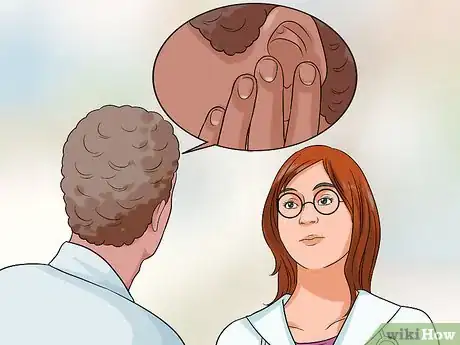


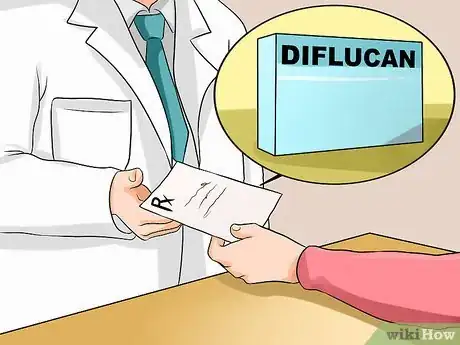




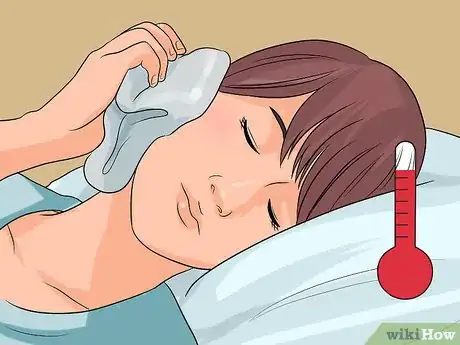


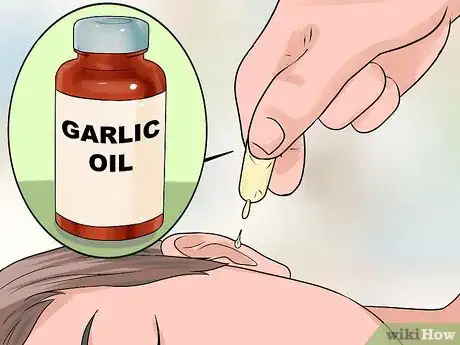

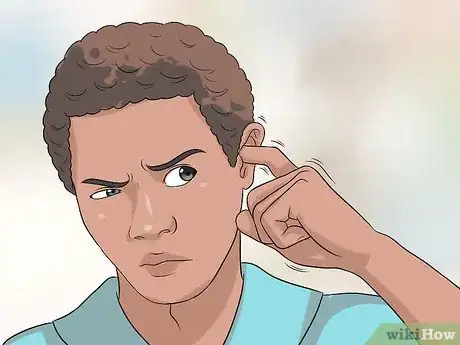
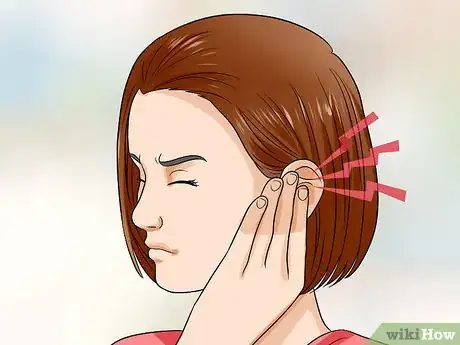
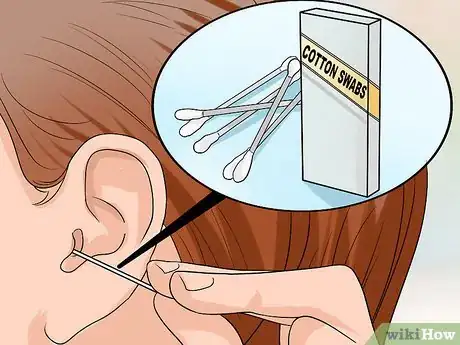


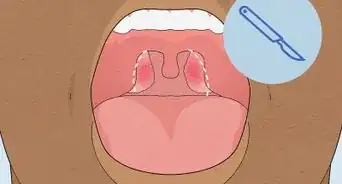
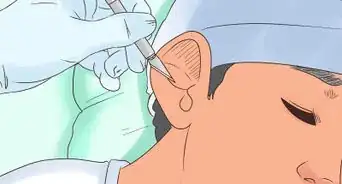




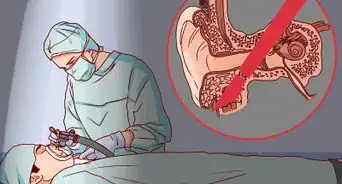


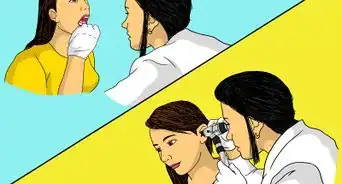














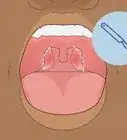
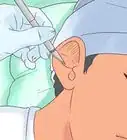




































Medical Disclaimer
The content of this article is not intended to be a substitute for professional medical advice, examination, diagnosis, or treatment. You should always contact your doctor or other qualified healthcare professional before starting, changing, or stopping any kind of health treatment.
Read More...